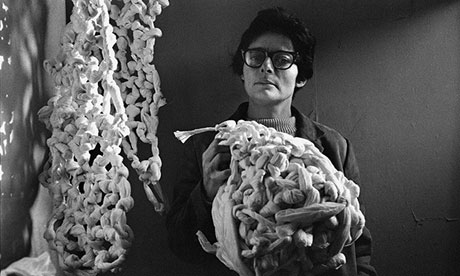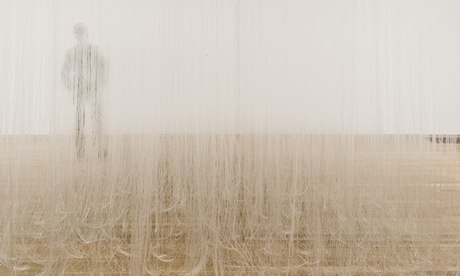Mira Schendel at Tate Modern.

Born in Zurich, to parents of Jewish heritage, Schendel was brought up in Italy as a Catholic and studied philosophy at the Catholic University in Milan. In 1938, because of her Jewish background, Schendel was stripped of her Italian nationality and forced to end her studies. As an 'undocumented refugee she passed through Switzerland, Austria and on to what then Yugoslavia. After the war, in 1949, she emigrated to Brazil, where she began her career as an artist.
In the city of Sao Paulo she joined a community of émigré intellectuals and began to explore ideas concerning aesthetics and philosophy. She recalled: 'I started painting in Brazil. Life was very hard, there was no money for paints, but I used to buy cheap materials and paint like crazy. It was a matter of life or death for me'.
She drew inspiration from Morandi, de Chirico and Klee. She also began to question the flatness of the picture plane and to move her work towards abstraction. Her work constitutes an experimental investigation into profound philosophical questions relating to human existence and belief, often addressing the distinction between faith and certainty, and examining ideas of being, existence and the void. She saw her work as activating the void, thus poised between being and nothingness.

Untitled, 1963
In her early work she experimented with various modes of abstraction, both in painting and drawing. Her work in the 1960s is characterised by a move towards geometry, revealing the influence of concrete painting, a form of abstraction where the composition, free of figurative or symbolic references, stresses the artwork as an independent object.
'No matter how much I use elemental forms, the sensory element of the brushstroke, the texture, is always there; for me this is very important. I would never make a completely smooth painting'.
Untitled, 1960 (gouache on wood)
Untitled, 1964 (tempera on agglomerate)
Untitled, 1964 (tempera on agglomerate)
Untitled, (Rectangles on a Brown Ground), 1960s, (oil on canvas)
Untitled, 1960s (tempera on canvas)
Untitled, 1960s (oil on jute)
Untitled, 1960s (oil on jute)
Untitled, 1964 (tempera on canvas)
Untitled, 1960s (tempera on canvas)
Untitled, 1960s (tempera on canvas)
* * *
The Return of Achilles, 1964 (oil on canvas)
The Return of Achilles, 1964 (oil on canvas)
The two paintings above are a combination of text and symbol. They both refer to Homer's epic poem the Iliad, but the quotation incorporated into one of the compositions is taken from a text by British theologian John Henry Newman, a meditation on the nature of faith and certitude which aimed to demonstrate that it was possible to believe that which could not be absolutely proven. Her interest in Newman is related to her reading of Ludwig Wittgenstein - this renders these two paintings among Schendel's most enigmatic works.
Untitled, 1964, (oil on canvas)
Untitled, 1964, (oil on canvas)

Dronguinhas, (Little Nothings) , 1964-66 (Japanese paper)
In creating these soft sculptures, Schendel said she aimed to create 'something technically primary and easy. From a Western point of view these sculptures could be seen from the perspective of a phenomenology of being. From the Eastern point of view, well, they relate to Zen'.

Dronguinhas, (Little Nothings) , 1964-66 (Japanese paper)
Within a year she produced 2,000 of these drawings or monotypes. This swift, yet rigorous and intense execution came to define her mode of production. The Monotypes are marked by Schendel's use and exploration of language. Often combining different languages, Schendel addresses concepts of belief, being and nothingness, and 'the void'. Drawing on philosophical ideas of phenomenology (the study of consciousness) she considers how we exist in the world (Umwelt or environment) with the world (Mitwelt or social world) and within ourselves (Eigenwelt or inner world).
Monotypes, 1964-65 (oil on rice paper)
Monotypes, 1064-65 (oil on rice paper)
* * *
Graphic Objects, 1968 (installation - rice paper)
A development of Schendel's delicate drawings on semi-transparent rice paper combined with clear acrylic, these works aim in their form to create a sense of visual, temporal and spatial 'transparency'. She said that 'while pursuing transparency as an issue I arrived at the object'. Her concept of transparency was derived from the writings of the German philosopher Jean Gebser who used the word to refer to human consciousness, experience of time and to a form of the spiritual. The Graphic Objects also explore language and corporeality.

Graphic Object, 1967
Looking at individual works

Graphic Object, 1967-68

The works have neither a front nor a reverse and can be read through their transparency so that the letters become reversed, or 'anti-text'.
* * *
Little Train, (rice paper)
Little Train illustrates her continuing interest in the theme of transparency as well as embodying the extreme delicacy of her work. They are made from the same sheets of rice paper as the Monotypes and Graphic Objects. However, in this case the blank pages are left loose, suspended across the space on a cotton thread.
* * *
Still Waves of Probability, 1969
An installation of thin, almost transparent fibres which is accompanied by a text from the Old Testament 'Book of Kings'. The relationships of the text to the installation concerns manifestations of the invisible and the relation between knowledge, faith and certainty. 'The theme is the visibility of the invisible, that is, of things that are in action, but without our being able to see them, such as the laws of physics or spiritual processes'.

'I am perhaps beginning a more silent phase... Listening (to silence also). Listening for liberation'. Through this work she sought to express the aim of humankind, 'to be, faithfully OF THIS world. And yet not to be of this world. With all its love and joy and also the inevitable suffering, with devotion and without illusions'.
* * *

Homage to God - Father of the West, 1975

The 1970s ushered in new modes of production for Schendel, notably her use of spray effects in her drawings. Homage to God - Father of the West consists of sixteen spray-painted drawings with transfer lettering that spell out fragments and passages from the Old Testament, particularly drawing from the Psalms. Typically of Schendel, the series uses multiple languages - Portuguese, German, Italian and English.

This series deals with themes of faith, Godly power and acceptance. Schendel struggled throughout her life with the teachings of Catholicism that she had been brought up with, contrasting them with her extensive readings of Western philosophy and Eastern thought. However, for Schendel, there were no easy solutions. The church had been instrumental in helping her escape Fascism in the 1930s, and also, through the Dominican order, presented a source of resistance to the dictatorship in Brazil.
* * *
Variants 1977
The installation, in the form of a constellation or cloud, is the culmination of her series of Graphic Objects, demonstrating how she 'spatialised' drawing, intending it to be seen from both sides and experienced, as well as 'read'.
It is comprised of ninety-three small 'graphic objects' on mathematical themes, ninety-two of which are executed in white on white, while a single one is white on black: Schendel had often used this device in which a focal point reverses the balance of black and white, for instance in her Little Nothings, and can be seen as a continuation of her interest in the balance of opposites, stemming from Eastern thought: 'asymmetry is one of the great lessons of the people from the East... I think the West has always understood symmetry better. It is rare for a drawing of mine to be symmetrical. In general, intuitively, I run from symmetry'.
* * *
Dactiloscrito, 1975 (typed letters and letraset on paper)

Untitled, 1980s
In the 1980s she returned to painting, creating a series of tempera and gold leaf works. These have often misinterpreted as expressions of decorative luxury - and because of this were vandalised at their first exhibition - or as being a reference to religious art, which invested gold with symbolism of the divine. In fact, they are a formal expression of a balance between opacity and transparency - while the matt, tempera paint absorbs light, the gold is reflective and therefore transparent. They also refer to the determination of the Self.

Untitled, 1962
Alas, I was not able to photograph or find images on the internet, of my favourite paintings which were part of this series, a number of black and white works...
* * *
Battens, 1987
Abandoning her usual delicacy to produce works that were deliberate and forceful, the black wooden bars that protrude from their surfaces address the body, space and environment of the spectator. Schendel explained how they were connected to the political situation of Brazil in the late 1980s, the first time she had made such an explicit link: 'this type of work ... was born of a moment of indecision, out of the disorder Brazil was plunged into ... when it looked like we were living in some tropical Weimar ... like everyone else, I was in need of direction, of some bearings. These works were a response to the marasmus of that time'.
* * *
Finally, a video that I was able to download, that is not only a virtual walk through parts of the exhibition, but which also presents an analysis of some of her work.
Source: Tate booklet on the exhibition.





























Very interesting introduction to an artist I knew nothing about
ReplyDeleteThank you wildswan. It was an amazing exhibition and I really don't feel my photographs do it justice - I knew nothing about Mira Schendel before going to the exhibition, but I am glad I went.
Delete